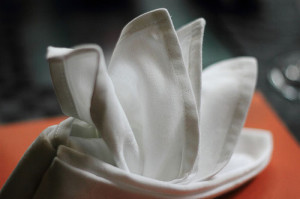It happens to all of us: we are at an event where a meal is being served, and the round tables are stuffed with utensils, glasses, plates and tableware. If you aren’t careful you can end up taking someone else’s napkin or eating your neighbor’s bread.
The real problem in this scenario is that most often in these situations we are with people we want to impress (or at least not insult). And even if we learned the basics at home, at a crowded table there are too many options, and everything is so close it is hard to distinguish one person’s place setting from another. But I have a couple of easy tricks to minimize banquet embarrassments.
The napkin is the first challenge. In some cases it is obvious, like in the setting above; but in other situations that is not the case. The napkin will almost always be in a napkin ring, on the table, under the utensils or artfully placed in one of the cups or glasses.

A napkin ring is usually easy to distinguish since it typically rests in the center of the place setting in front of you. As you remove the napkin, place the ring out of the way at the very top of your place setting. If the napkin is on the table often it is folded, but also placed in the center making it easy to distinguish which is yours. If the napkin is placed under the utensils, a proper setting will have it placed under the forks on the left side of the setting. If it is waiting in a glass, it will be the glasses on your right (more on that in a moment).
Once you find your place, you should put your napkin in your lap. Although in some cases it may be appropriate to tuck it in at the neck, when in doubt, the lap is always a safe bet. If you have to leave the table and you want to hold your seat as people enter the dining area and find their seats, placing your napkin over the back of your chair is considered standard practice.
As you sit down to eat, the most common mistakes are made in relation to the bread plate and beverage glasses. On a rectangular table, settings are often grouped in a more obvious manner; but on round tables, as the setting nears the center, there are rarely any distinguishable boundaries between the place settings.

Luckily we can give ourselves a quick reminder using our hands and fingers. I would love to take credit for this, but I learned this at an event years ago and it was probably one of the most useful things I learned all year! Hold your fingers as shown above and you see the left hand forms a “b” (“B” is for bread) and the right hand forms a “d” (“D” is for drink). Therefore, the bread and/or bread plate is closest to your left and all the glasses and cups on the right belong to your place setting. So if your napkin is in a glass, grab the napkin on your right.
The last area of confusion is related to the utensils. This, however, is often the easiest to manage. The simple rule is: work from the outside in (start with the utensils on the outside of the setting for the first course and move toward the plate as you finish courses). If you are not sure, in most situations the wait-staff will take away the appropriate utensils as they clear the setting between courses. Dessert plates and utensils – when they are pre-set and not brought out during the dessert course – are typically placed at the center top of the setting.
Are there more hints, tips and tricks with regard to dining etiquette? Of course! But I have found the tips included here solve most of the embarrassing situations that can arise at a banquet.


